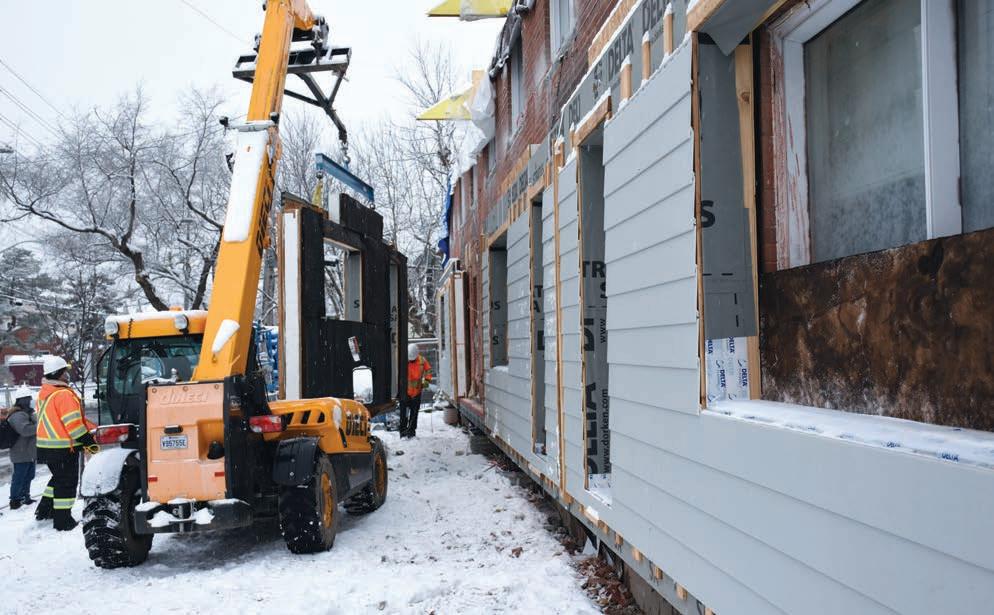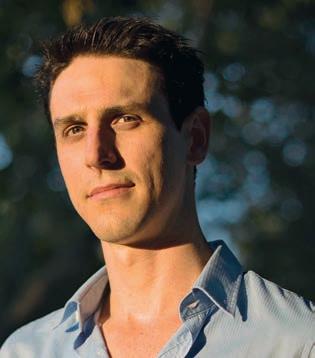
3 minute read
CONVERSATION
PEER Support
Prefabricated panels can add an energy-efficient building envelope over an older, leaky one.
In the Ottawa neighbourhood of Overbrook, a Natural Resources Canada (NRCan) CanmetEnergy research centre has been working with Ottawa Community Housing (OCH) on the Prefabricated Exterior Energy Retrofit (PEER) net-zero pilot project to make existing buildings more energy-efficient by adding panels to their façades. We spoke to Mark Carver, the CanmetEnergy housing team project leader, and Dan Dicaire, P.Eng., OCH’s manager of conservation and sustainability, about this effort.
Mark:
We identified disruption as a major barrier to traditional deep-energy retrofits, which are noisy and dusty. That sparked this idea of a ‘kit of parts’ that could be applied largely from the outside.
The process involves four major steps. The first is ‘building capture,’ using 3-D laser scanning or photogrammetry to rapidly, accurately measure dimensional data for a digital model of the building. From that, we can design a new enclosure for the building. We custom-fabricate the panels with control layers for water, air, vapour and thermal control. After they are preassembled in a factory or off-site shop, they are lifted or craned into place to complete the retrofit. This can really reduce the amount of time needed on-site.
By addressing space heating demand, we can dramatically reduce overall energy use. Then we can right-size the mechanical systems, add ventilation and offset remaining loads with a reasonably sized photovoltaic (PV) array that will fit on the building, to get all the way to net-zero.
Dan:
With the building envelope retrofit, we have reduced the heating and cooling loads so much inside, we can go with a much smaller, more efficient, electrified solution. We’re taking out the hot water tank and natural gas furnace and putting in a heat pump and retrofitting the forced air system with a heat recovery ventilator (HRV).
Once we’ve got that new building envelope and mechanical system, we need this small amount of energy we can cover with renewables. Our southern-facing roof exposure will feature 34 kW of solar panels. Each home is getting its own piece of that array, generating as much energy as the tenants use for plug loads and all the mechanicals, effectively making the homes net-zero.
This is a really good model for social housing retrofits. These units were built in the 1950s and ’60s and are at their life-cycle tipping point. If we do not do some work, we might lose them. This is not just an energy question; the city is in the middle of a housing crisis. We want to ensure we are maintaining our existing stock.
Our cost is around $200,000 per unit, which includes a lot of upfront consulting we will not need to repeat. With economies of scale for multiple projects, we are hoping to drive that cost all the way down to $100,000, probably even lower. Investment today makes sense, to offset consumption for the future. And this approach is extremely applicable to pretty much any other templated buildings out there. There is a lot of reproducibility.
Mark:
We see the affordable housing sector as a real catalyst market for scaling up this type of concept. If we are serious about addressing emissions, this is probably one of the only ways to industrialize the effort to get to where we need to be by 2050.
There is a role for consulting engineers going forward. The Pembina Institute and BC Housing have the Reframed initiative. There’s also Recover in Nova Scotia. I would encourage anyone who is interested to check those out. CCE

Mark Carver
This article is based on a recent episode of The Better Buildings Podcast. To hear the full conversation, visit www.canadianconsultingengineer.com/ podcasts.

Photo courtesy CanmetEnergy
Bradford White’s eF Series®
PERFORMANCE THAT’S PROVEN.
Learn more about the eF Series at bradfordwhite.com

When you’re specifying a water heater for a commercial application, you don’t want to take chances. The eF Series® Ultra High Efficiency Gas
Water Heaters deliver proven performance and efficiency to meet virtually every commercial need.
• Flexibility. The eF Series® offers a variety of capacities from 60 to 119 gallons. • Innovation. The eF Series® features BMS integration with remote monitoring for quicker, easier troubleshooting. • Efficiency. ENERGY STAR® models available up to 94% efficiency. • Ultra-Low NOx models available that comply with the latest ultra-low NOx requirement (14 ng/J NOx Limit). • Quality. Includes exclusive features like the
ICON HD® intelligent Gas Control for better performance, Hydrojet® Sediment Reduction
System for reduced maintenance and Vitraglas® tank lining for longer life.






